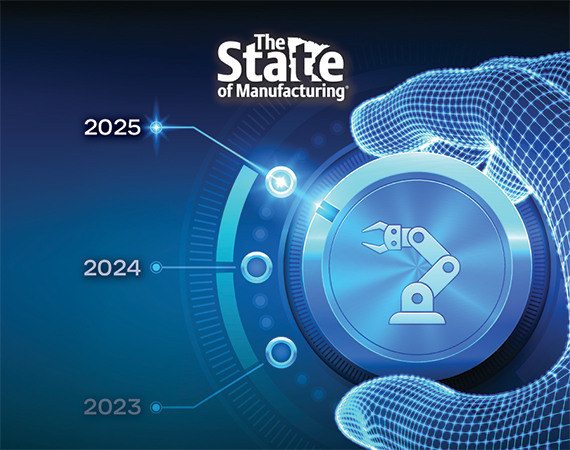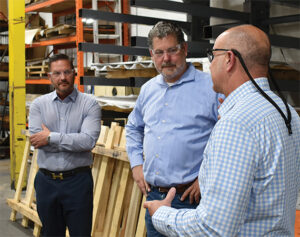Enterprise Minnesota (EM): When you look at 2025, are you predicting a good economy? Expansion? Recession?
The challenge is, because most of us service other customers and don’t build our own product, understanding how the variety of industries we serve could be impacted. We can only see what our customer tells us. You worry about whether or not it’s going to be a growth year. We were finishing a big expansion and a recession hit. Rates went up, buying equipment got more expensive. Now we’re coming out of that hopefully, at least that’s what they tell us, so we look to 2025 as a recovery year.
We are in a little bit of a different scenario. Starting in early 2021, our sales boomed, and we have been trying to work off a large backlog for a couple of years. For the first time, certain parts of our business are seeing orders slow down. We still have backlog to keep going, but it looks like 2025 is going to be slower.
This year we slowed down so much we still had to buy all our product. Next year, we won’t buy anything for six to nine months.
I think it depends on what markets you’re touching. It seems like some of our customers with five-year plans are already set, and they are so capital intensive that even if the market turns to crap, they’re going to continue to their best ability. They already have billions of dollars started. We’re just a small piece of that, unfortunately. But that business is a longer strategic investment, so those tend to continue even if the market doesn’t do well. So, we have a really hard time predicting. You have to play defensive, but you also have to prepare for those booms so that you can take care of your customers. If you can’t, they are going to find somebody else who can.
I agree. We’re forecasting a 10% reduction in sales, and Monday we move into our new construction. The timing is not good, but in the future, we’re going to need that space.
We see a lot of indicators that staffing is a big issue still, yet it’s softening. We have also heard interest rates in some industries impacted capital expenditures, and others not so much because of either size or product offerings. I would say it is a wait and see, but I’m generally optimistic that once the election is done things will start picking up again.
Most of my conversations right now don’t have workforce issues as a top priority or the biggest issue anymore, which is nice compared to a year ago. It was pretty slow this summer with capital purchases, expansions, things like that.
EM: What is your biggest challenge now as a manufacturer and in the coming year?
The ability to be agile. If that boom comes, how do you cover it? If it doesn’t, how do you resize and restructure to survive the next level of whatever it might be? Hopefully not a recession, but we don’t know. We don’t know what the future holds.
Kind of the same thing for us. We can’t scale up fast enough for what we have seen the last couple of years in terms of expansion. In some of our markets, we are hearing from our customers that we should be expecting continued growth. In other areas, not so much. So, how do you plan for that, both from a people standpoint, even though it’s easier to find people today than it was two years ago, and on the equipment side — lead times for new equipment and expansion are still very long. It’s tough to make decisions today on things that will have an impact a year or so from now.
One thing we are struggling with right now is reduction in business. How long is this going to last, and how much cash do you want to burn keeping your employees? When it gets busy, they are going to be hard to find again.
EM: Let’s talk more about that topic — talent and leadership development. Are there still challenges with finding people compared to, say, a year ago or not so much?
I would say it’s still challenging. I mean, you can find one or two good candidates, maybe you get five applications instead of two applications like you did last year. But it’s not like you can just put a sign out and get 20 employees in a week who are all ready to hit the ground running.
I think the quality of the applicants is not there. We need the right people who fit our core values, can do the job, and you can depend on, and we are just not seeing that very often. When we find somebody like that, we hold on to them really tight.
We have been looking at technology. If you can’t find good individuals or people who have the skillset you need, you bring in technology. We spent the last year putting in technology to replace people. We are still investing in people because it’s the right thing to do, but we just got two more industrial robots in. With the caliber of people available, it is challenging.
EM: What are some things you are doing to retain your employees?
Technology has been big. The struggle out there is finding good employees. For our growth, it was essential that we invest in technology because you can’t find people with that tribal knowledge. To back up a little bit, I think we are still feeling the effects of COVID, especially with the professional workers we want to bring in.
We’ll interview people, they want to work hybrid, work from home, that type of stuff. In my opinion, that’s not reality when you’re in manufacturing. You have to be there with your people, your team. We’re in central Minnesota, and we are having to recruit out of the Twin Cities. To get someone to relocate and then offer competitive wages in central Minnesota is a challenge, but we’ll do it if it’s the right person, the right fit, and we feel that they are committed.
EM: What are you doing to get people?
Historically, we didn’t utilize recruiters, so we’re having to invest heavy on the recruiters. We might come up with 10 candidates and one comes out of it. We have raised our wages to be more competitive to bring that talent in. But that all goes back to an investment in technology, because technology increases your margins and then you’re able to use that to bring better talent in.
EM: Are you investing in automation, and do you see more investment in automation in the next year? And what is your definition of automation?
We are looking at an ERP (enterprise resource planning) system. We are a lot smaller than most of the companies here, so hoping that will help streamline how we do things. Also, definitely looking at automated filling. We have done a lot of manual processes up to now, and we are expanding with bigger equipment, making bigger batches.
We are investing in systems to make our office people more efficient at what they do. That way, you don’t have to hire as many people, just have better information at their fingertips. We have a new $3 million press coming in next month, and it’s going to eliminate the need for hiring three people. We are going to be making two parts off that press with one operator instead of one operator on each press. It’s making people more efficient.
We are doing the same. It’s not about replacing people with technology; it’s about finding technology that makes people more efficient. Instead of just trying to hire a button pusher, we hire somebody and turn them into a utility player who we can move around as our production flows through a process.
I think, too, when you talk about technology, the education part is so big. We can invest in a piece of equipment, but what good does it do if it’s just sitting in the corner and you don’t have the right people to run it? That’s where we have been utilizing our area technical colleges to bring these people in. You’re seeing a shift with the youth; they are looking for opportunities or careers out there.
When you automate a program, you need somebody who can read a drawing and take that drawing and convert it into one of these automated tools. We’re investing in AI that can do a lot of that work and a lot of that programming.
EM: Are others using AI? Is it a benefit? Are you nervous about incorporating it?
We are not heavily invested in it, but our IT folks say they use it every day to program the different functions of our online tools and streamline their work.
AI scares the crap out of me because of attacks — attacks on your systems. But at some point, I think we are going to have to use AI to fight those attacks.
It has been a wonderful tool on the sales side. You can find anyone at any place, any name, any title, any phone number, and basically make a direct connection. Prior to that, it was more of a networking type of thing to get in the door. Now it’s one click of a button and before you know it you’re talking to a VP of operations.
We use AI a lot. We have a program for contract review, where we load a contract with our set of terms and it compares and tells us where we are on compliance. We also use AI for our accounts payable department. Invoices come in, it compares and does the three-way match and puts it all in the system so that we can reduce the number of people in financing. There are things that AI can do that reduce the monotonous work that people do. So, we are using it in many areas of the business.
EM: Let’s talk about supply chain. Is it still an issue?
Our supply chain is healthier now than it has been in a long time. It’s not an issue for us anymore.
The supply chain is pretty good right now. What I am seeing from some of our suppliers might be related to that talent gap. We’re seeing more mistakes coming in from suppliers than we have seen in the past. So, that’s been a challenge. Before you just couldn’t get the stuff. Well, now we are getting the stuff, but it may not be coming in the way we need it to come in.
EM: Some manufacturers have said that their customers are holding on to inventory longer because of uncertainty. Are you seeing that amongst your customers as well?
Our customers are asking us to hold on to their inventory longer. They want it, they just don’t want to ship it. We became their warehouse, which is interesting because our supply base is pretty stable. We’re starting to get pushback from some of our larger customers who think they know how to buy product better than we do.
We had customers who were replacing excessive orders and building inventory at a time when lead times went long and its supply chain was unreliable. As things have kind of stabilized the burning inventory, we are seeing orders normalize.
We service the food industry, and with prices the way they are right now, especially with proteins, freezers are full. People are not wanting to pay, let’s say, $8, $9 for a pack of bacon or something. So, the inventories on that end, depending on the business, are higher than they were before. It is a challenge because these big companies can’t stop. They can’t slow down.
EM: How many of you have a formal strategic plan in your organization? Are you well-positioned for future succession?
Yes, we have a strategic plan, and yes, we formalized it more this year.
We have one; it can be better. We have some new leadership within the business, and it’s time to bring us all on the same page and make sure we are all over the next one to three to five years.
Yes and no. We do have a strategic plan. We follow EOS, so that helps us with our vision, but we do not have an exit strategy at this point. We are really trying to scale up at this point and increase our value. But we have not gone that far into the future of what’s going to happen when the owner’s ready to retire.
We have a strategic plan, but not one for exit time for the owners. We plan year to year, different stages, we have big meetings once a month, so we communicate all the time. Guess maybe we should start talking about exit strategies, too.
We are a family-owned company and currently transitioning to a fourth generation, so regarding an exit strategy, there is no exit. But when you talk about strategy, yes, we do. We have one-year plans, five-year plans, and, believe it or not, a 100-year plan. We are a 125-year-old company. How do we continue to exist for another hundred years? We spent a lot of time with that at the leadership level and communicating it to the whole organization.
We have a strategic plan. I think it was essential to the growth of our business. We meet quarterly on it. We set our one-year, five-year, and 10-year goals, and we bring our entire management team in on that strategic plan. I think where we are probably lacking a little bit is in succession planning, and we try to work through it, but having owners who have been in the business for long, it’s tough to let go and understand what that’s going to look like in the future.
EM: How do workforce laws, including paid family and medical leave, impact your business?
So, this year the earned sick and safe time (ESST) has had a pretty profound impact on our business. We’ve paid people to be out anyway, now they don’t have to call in. Our four supervisors are standing there wondering, “Well, who’s going to show up today? What do I schedule?” Let us run our business. We have provisions for paying employees for sick time. Just get out of our way.
I would say listen to us. It just feels like we voice our opinions, and we throw them all out there, and the government and the legislature just get tied up in this big knot and it doesn’t seem to move. We can talk about it, but as a leader of a company I don’t feel like we are really being heard. It’s frustrating.
We look to buy companies that fit us strategically, and we tend to not look at Minnesota because the regulatory environment is not favorable to businesses. It would have to be an amazing opportunity here for us to consider Minnesota given that it’s so hard to do business here.
The challenge for us is being competitive in the future if new mandates keep coming that cost us more money. With ESST or paid family and medical leave, it’s hard enough finding employees and then allowing them to come and go as they please doesn’t help us schedule and plan work. With the added cost, we are not competitive with other companies that do what we do in Wisconsin and Iowa and North and South Dakota.
How do we continue to be competitive in the market when the state is taking away that competitiveness? We have done our last expansion in Minnesota, that’s for sure.
Return to the Winter 2024 issue of Enterprise Minnesota® magazine.


